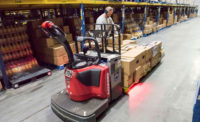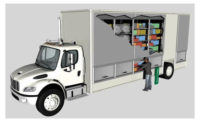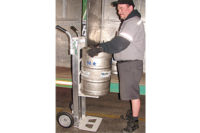Increased SKU counts, tight warehouse and in-store spaces, and delivery personnel who manage heavy cases and kegs are driving innovation of new mobile carts and hand trucks that are designed to improve ergonomics and enable warehouse workers to safely and efficiently stack, retrieve and deliver products.
Mark Koffarnus, director of national accounts for Greenville, N.C.-based Hyster Co., affirms that direct-store-delivery (DSD) is a labor-intensive delivery format, with associated labor, ergonomics, safety and efficiency challenges top-of-mind for beverage distributors.
“On the ground, delivery personnel must navigate a variety of environments and terrain, from distribution facilities and uneven parking lots to congested convenience stores and receiving docks at retailers,” Koffarnus says. “Delivery personnel also face longer routes, with more stops as retailers get more frequent, smaller-quantity deliveries.” To help delivery drivers, Koffarnus suggests that lithium-ion battery power can offer longer runtimes and opportunity charging to help power through longer delivery routes. He also recommends carts and hand trucks utilize a load retention strap to help with stability when moving loads over rough terrain like poorly paved parking lots.
The Hyster W45ZHD walkie pallet truck has those features and more, and the company recently launched an end rider series, which offers truck-mounted lights, a comfortable platform cushion, optional power assist steering and other features to give operations a competitive edge.
Shelley Bell, manager of industry marketing at Yale Materials Handling Corp., Greenville, N.C., also highlights the importance of the lithium-ion battery, which is a user-friendly power source that doesn’t derail delivery schedules because it can be charged from a standard 120V outlet.
“Beverage delivery personnel face a landscape that resembles an obstacle course almost every shift, with narrow lift gates, uneven terrain, congested store entrances, store rooms, coolers and more. This places a premium on maneuverability and visibility,” Bell says.
Yale offers a DSD package for the MPB045VG walkie designed to meet multiple challenges, including an ergonomic handle design, which allows for easier maneuverability in stores and on lift gates by allowing the operator to stand beside the truck with one-hand throttle activation and full visibility of the truck from end to end, Bell says.
Because of tight environments in-store and in the warehouse, hand carts need to be lightweight in design but have extreme rigidity and structural integrity so they won’t fail in the field, be equipped with an updated handle design and steering chassis to foster better maneuverability and visibility, and include truck-mounted lights and hand brake options, if possible, experts note.
“Truck-mounted lights are a beneficial feature to boost operator and pedestrian awareness,” Bell explains. “For example, LED fork lights can provide low-level illumination in low-light applications such as dim storage aisles and dark delivery trailers.”
Also making the hand truck “worth its weight in gold” is its ability to extract customer orders from basement storage locations. “That’s when a hand brake option or accessory on your hand truck becomes extremely handy,” says Carl A. Boettcher, chief executive officer at HTS Systems, Scranton, Pa.
“Beverage box trucks equipped [with] incline ramps or when the worker must descend stairways into lower level storage areas, makes the disc or tire-paddle brake a safer option,” he says. “… With the exception of one- to two-case (hand carry) small orders, it’s extremely important to remember that every beverage case, beer keg or soda fountain (syrup) tank container unloaded from a large beverage truck requires a hand truck.”
A driver’s right hand
Experts note that hand trucks are indispensable pieces of material handling equipment literally required to do a lot of heavy lifting by transporting seven to eight cases of soda or beer, kegs or a syrup tank from truck to a retailer.
HTS Systems’ Boettcher suggests that all of the flexing, bending and wear-and-tear will lead to inevitable alloy fatiguing and failure — causing a broken hand truck to increase route times, labor costs and also doubles the likelihood of a work-related injury.
From a product designer and engineer’s point of view, Boettcher notes that the hand truck’s main frame gets its structural rigidity and strength from the three to four horizontal cross-members that connect the two extruded aluminum vertical side-rails together.
“Several hand truck manufacturers now use high-strength stainless steel [and] high-pressure cherry rivet fasteners to achieve a stronger more reliable connection to both extruded components,” he says. “T[1] he hand truck is a route drivers’ right hand; it’s essential for route productivity, delivery safety and reducing workman compensation claims.”
Raise the job IQ
Although carts and hand trucks provide a vital way for delivery personnel to load and deliver products, Greg Ellis, president of Precision Distribution Consulting (PDC), notes that picking to carts in the warehouse is about as old as warehousing itself.
“Most of this has been replaced by picking to pallet jack or forklift … [because] a loaded pick cart of beverages can weigh up to 600 pounds,” he says. “That’s a tough way to make a living in the warehouse.”
Located in York, Pa., and Denver, PDC originally designed and unveiled Manuverate in 2016 at the National Beer Wholesalers convention. Released in April, the newest iteration — the Manuverate Keg Cart — is a game-changer because of its ability to safely unload the 165-pound barrel beer kegs from the side load delivery truck, and is ergonomically superior when used with the company’s patented Manuverate Keg Module, says Manuverate’s President Michael R. Blouch.
“Our cart design protects both the delivery driver and the product container itself because it isn’t necessary to drop the keg onto the ground,” Blouch says. “The new Manuverate Hand Cart also has the flexibility to be used to unload and transport case goods or totes ergonomically with or without the Manuverate module.
“As case good products are being unloaded, the delivery driver can more easily and ergonomically transfer the products from the delivery truck side bay onto the adjustable raised platform of the cart and [is] lowered to the ground at the push of a button,” he continues. “This avoids the need to do the excessive bending and lifting, which causes physical strain, excess fatigue and potential acute or chronic injuries.”
In addition to reducing accidents, injuries and Workman’s Compensation claims, the lightweight Manuverate Hand Cart has provisions for a hand brake, which locks the wheels in place to provide added cart stability. The cart also can be front or read mounted on the vehicle using the standard truck rack.
“Presently, there are no available hand cart technologies that have all of these unique features and benefits with the capability and flexibility to handle one or two kegs and case goods or totes, thus being a replacement for the existing conventional style of hand carts,” Blouch says.
PDC’s Ellis notes that this type of significant, disruptive innovation is essential for the beverage industry.
“The margins and workplace conditions can no longer support such traditional methods and a lack of appreciation for the frontline employees’ work environment,” Ellis explains. “The tools for the delivery personnel need to be designed for the job. In the past, [on] too many occasions, the first line performers are fitting the job tasks and job to equipment that is available.
“… The answer needs to be a picking and delivery method that doesn’t sacrifice safety and job satisfaction in either the warehouse or on the street,” he says. “In today’s day of customization and advanced manufacturing capabilities, we can provide the exact delivery and merchandise employees need to do their jobs.”




